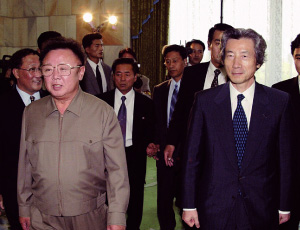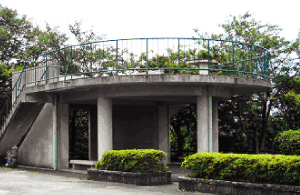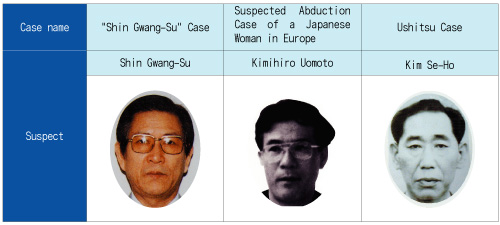1. Introduction
Regarding the issue of abduction of Japanese nationals, Chairman Kim Jong-Il of the National Defense Commission of North Korea acknowledged several of the abduction cases at the Japan-North Korea Summit Meeting held in September 2002 that the incidents were the work of "some agents in the special services who got carried away by heroic illusions," and offered an apology.
Five abductees who North Korea informed were still alive were returned to Japan the following October. then, family members of these abductees were returned to Japan in May and July 2004.
 |
| Japan-North Korea Summit Meeting (September 2002,Pyongyang) (Photo: Kyodo Press) |
The purpose of the abductions of Japanese nationals by North Korea is not exactly clear. Nevertheless, judging from the various information available, it may be inferred that the main purpose of the abduction of Japanese nationals was to train North Korean agents on how to pretend to be Japanese to enable North Korean agents to impersonate them. Chairman Kim Jong-Il explained at the Japan-North Korea Summit Meeting that the purpose of the abduction of Japanese nationals was, "For one, so that agents in the special services could learn Japanese; and two, so that they could use another person's identity in order to enter South Korea."
Furthermore, the ex-wife of the "Yodo-go" hijacker has testified that she was instructed to capture Japanese nationals by Takamaro Tamiya, who had been instructed by then President of North Korea Kim Il-Sung, "To promote revolution and create a party in Japan that will play a commanding role. To create such a party, Japanese nationals who will serve as the party's backbone must be discovered, captured, and educated." This indicates that as a background to the abduction of Japanese nationals, there was an objective to round up human resources for the purpose of carrying out a Japanese revolution based on the dictums (instructions) of then President Kim Il-Sung.
3. Outline of Suspected Abduction Cases by North Korea (11 Cases, 16 Abductees)Regarding the suspected abduction cases of Japanese nationals by North Korea, the whereabouts of the victims were unknown, there were no witnesses to the abductions, and almost no remaining evidence. Under such circumstances, the police have been doing their utmost to further advance investigation efforts.
Specifically, the police have been making earnest efforts to collect and compile related information and evidence by questioning the relevant parties, searching for evidence by such means as inquiries in the vicinity, exchanging information with the relevant domestic and overseas agencies, and similar measures. As a result of such steady, longterm efforts, in April 2005 the police concluded that the case concerning Minoru Tanaka, who disappeared in Kobecity, was another suspected abduction case. Presently, there are a total of 11 suspected cases of abduction involving 16 abductees.
The outline of each case is as follows.
Outline of "Suspected Abduction Cases of Japanese Nationals by North Korea"| Date and location of abduction |
Case name | Case summary |
| September 1977,Fugeshi County, Ishikawa Prefecture | Ushitsu case | A North Korean resident was engaged by a North Korean Agent to gather data concerning US forces stationed in Japan and to spy on the Republic of Korea (South Korea). He was also ordered to "take an unmarried Japanese male between the age of 45 and 50 to North Korea." The North Korean took a Japanese man residing in Tokyo who had been an acquaintance for sometime to a beach where the man was handed over to other North Korean agents who had arrived on a spy boat. (An arrest warrant was issued for the main perpetrator, Kim Se-Ho, and he has also been placed on an international wanted list.) |
| November 1977, Niigata City, Niigata Prefecture | Suspected Abduction Case of a Young Girl | Megumi Yokota, who was 13 years old at the time, disappeared while she was on her way home after extracurricular activities at her junior high school. She disappeared shortly after parting from a friend a few hundred meters away from the beach. |
| Around June 1978, Kobe City, Hyogo Prefecture | Suspected Abduction Case of an Ex-diner Employee | A North Korean resident and owner of a restaurant in Kobe received orders from North Korea, after which he convinced Minoru Tanaka, an employee at the restaurant, to leave Japan. Tanaka was taken abroad and later sent to North Korea. |
| Aroundune 1987, location unknown | Lee Un-Hae Suspected Abduction Case | A case came to light after Kim Hyon-Hui, convicted of bombing a Korean Air Lines airliner in November 1987, claimed that she "learned how to act like a Japanese person in North Korea from a Japanese woman called Lee Un-Hae who had been abducted from Japan sometime between 1978 and 1979," further adding, "Lee Un-Hae had said that she was forced to come to North Korea on a boat from Japan." |
| July 1978, Obama City, Fukui Prefecture | Suspected Abduction Case of Japanese Couple(Fukui) (Note 1) | Yasushi Chimura and Fukie Hamamoto left home by car saying that they were going on a date and never returned. Their car was found near an observation deck close to the beach with the ignition key on. |
| July 1978,Kashiwazaki City,Niigata Prefecture | Suspected Abduction Case of Japanese Couple(Niigata) (Note 2) | Kaoru Hasuike borrowed a bicycle from his family and left home saying, "I'm going out for a little while, I'll be back soon," but never returned. On the same day, Yukiko Okudo told a colleague that she had a date after work, but she disappeared after leaving her place of work. Hasuike's bicycle was found in front of a library located a few hundred meters from the beach. |
| August 1978, Hioki County, Kagoshima Prefecture | Suspected Abduction Case of Japanese Couple (Kagoshima) | Shuichi Ichikawa left home saying he was going to the beach to see the sunset with Rumiko Masumoto and never returned. His car was found near the seaside campground, with the doors locked. Masumoto also left home saying she was going to the beach with Ichikawa to see the sunset and never returned. |
| August 1978, Sado County,Niigata Prefecture | Suspected Abduction Case of a Mother and her Daughter (Note 3) | In the town of Mano, Niigata Prefecture, Miyoshi Soga and her daughter Hitomi left their home saying they were going shopping and never returned. |
| Around May 1980, Europe | Suspected Abduction Case of Japanese Men in Europe | Toru Ishioka and Kaoru Matsuki disappeared while living in Europe. Later, Ishioka's family received a letter from him that had been postmarked in Poland and posted in August 1988. It said that Matsuki, Keiko Arimoto, and he were all residing in North Korea. |
| June 1980,Miyazaki City,Miyazaki Prefecture | "Shin Gwang-Su" Case | This case was revealed by the South Korean authorities in June 1985. North Korean agent Shin Gwang-Su and others took Tadaaki Hara, who lived in Osaka Prefecture, to Aoshima Beach of Miyazaki Prefecture, where he was abducted and taken to North Korea by a spy boat. (An arrest warrant was issued for Shin Gwang-Su, and he has been placed on an international wanted list.) |
| Around July 1983, Europe | Suspected Abduction Case of Janpanese Woman in Europe | Around October 1983, Keiko Arimoto, who was studying in the United Kingdom, went missing after sending a letter to her family from Copenhagen, Denmark. Later, Toru Ishioka, who also went missing in Europe, said in a letter to his family postmarked August 1988 in Poland that he and two other Japanese, including Arimoto, were staying in North Korea. (An arrest warrant was issued for "Yodo-go" hijackergroup member, Kimihiro Uomoto, and he has been placed on an international wanted list.) |
| Note 1-3: Of those abducted in these cases, Yasushi Chimura, Fukie Hamamoto (current surname: Chimura), Kaoru Hasuike, Yukiko Okudo (current surname: Hasuike), and Hitomi Soga returned to Japan in October 2002 for the first time in 24 years. | ||
4. Status of Investigation on the Suspected Abduction Cases
For the North Korean agent Shin Gwang-Su, who executed the abduction of Tadaaki Hara; Kimihiro Uomoto, the "Yodo-go" hijacker who abducted Keiko Arimoto; and the North Korean agent Kim Se-Ho who was the principle perpetrator in the Ushitsu case, the police obtaind arrest warrants and placed them on an international wanted list. Japan is also demanding an extradition of these offenders from North Korea through the MOFA.
Besides the 11 cases involving the 16 abductees, there are other cases in which the possibility that abductions were carried out by North Korea cannot be ruled out and, therefore, the police are continuing with the necessary investigations and inquiries.
At the third round of the Japan-North Korea Working-level Consultations held in November 2004, NPA staff joined the delegation from the government of Japan. Regarding the "remains" that allegedly belonged to Megumi Yokota which were presented by the North Korean side to the Japanese delegation at the Consultations, DNA analysis experts carefully selected 10 bone fragments from which DNA could possibly be detected. These were then handed over by police authorities to research organizations of the highest national standard (Teikyo University and the National Research Institute of Police Science) for DNA analysis. The results showed that of the five bone fragments handed over to Teikyo University, four were detected to have the same DNA, while one had DNA from another person. However, neither set of DNA matched that of Megumi Yokota.
In addition, regarding the "remains" that were claimed to possibly be those of Kaoru Matsuki, the North Korean side handed them over to Japan, explaining that they were stored in the same place as the remains presented to the Japanese government delegations during their last visit to North Korea in September 2002. As such, it was suspected from the beginning that these "remains" were unlikely to be those of Matsuki. Nevertheless, a portion of the "remains" were selected and analyzed as a precautionary measure. The results from Teikyo University, which the police authorities commissioned to do the analysis, found that the DNA detected in the "remains" was different from that of Matsuki.
The police had already concluded in 1988 that six cases involving nine Japanese nationals who went missing were suspected abduction cases by North Korea. The police had also been explaining in the Diet that a case of one missing person in February 1988, five cases of eight missing persons in March 1988, and six cases of nine persons in April 1988 are cases suspected abduction cases carried out by North Korea, indicating that North Korea is suspected of engaging in acts that infringe on the sovereignty of Japan.
Later, the police concluded and announced that the number of suspected abduction cases amounted to seven cases involving ten persons in May 1997, and eight cases involving eleven persons in March 2002. At the Japan- North Korea Summit Meeting held in September 2002, Chairman Kim Jong-Il acknowledged the abduction of the Japanese nationals, and the North Korean side provided information on the fate of the abductees.
Taking such circumstances into consideration, the police concluded in October 2002 that the number of abduction cases amounted to ten and involved a total of fifteen persons.
Moreover, because there were other cases in which the possibility of abduction could not be ruled out, the police earnestly continued necessary investigations and inquiries. As a result, in April 2005, the case of Minoru Tanaka was newly concluded to be a suspected abduction case. Regarding this case, on the background of the change in various situations surrounding the recent investigations, a renewed investigation was conducted, under which concreteevidence was obtained from multiple witnesses.
The police wi l l cont inuetorally the ircollective strength in order to advance their investigations toward uncovering the whole truth behind the cases.
 |
| The site of an abduction (Fukui Prefecture) |
 |
| List of suspects on the international wanted list (related to suspected cases of the abduction of Japanese nationals) |